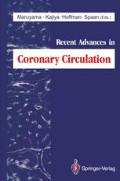Summary
Recently it has become clear that the deep myocardial vessels are pulsating due to cardiac contraction. Although it is known that the coronary arterioles show myogenic responses and play a role in the regulation of blood flow, the influence of pulsation on the mechanical propertes of the arterioles is not clear. We evaluated the mechanical properties of the coronary arterioles under pulsation with basic physiological frequency and different basic tone. Isolated porcine coronary arterioles (I.D. = 100–150 μm) were cannulated with two micropipettes. The luminal cross-sectional area (CSA) was measured using a fluorescence technique under cyclically (1 Hz) changing transmural pressure. After vascular tone was induced (active) by acetylcholine or abolished (passive) by bradykinin, the CSA was measured while the pressure amplitude was changed at a fixed mean level (60 mmHg). At all amplitudes tested, the isolated coronary arterioles in the active condition showed smaller compliance compared to those in the passive condition. The compliance was larger with greater amplitude of the pulsatile transmural pressure than with smaller amplitude of the pulsatile transmural pressure for both the active and passive coronary arterioles. Therefore, the physiological active arterioles pulsating with larger transmural pressure may have benefits in accommodating and discharging blood, and thus may contribute to the compliant blood flow. Raising the amplitude caused the normalized mean CSA in a steady state to increase under active conditions, and to decrease under passive conditions. The vasodilating effects of the pulsation may compensate for the extra compressing effects with increasing cardiac contraction.
Access this chapter
Tax calculation will be finalised at checkout
Purchases are for personal use only
Preview
Unable to display preview. Download preview PDF.
References
Hoffman JIE, Spaan JAE (1990) Pressure-flow relations in coronary circulation. Physiol Rev 70:331–390
Scaramucci J (1695) Theoremata familiaria viros eruditos consulentia de variis physicomedicis lucubrationibus juxta leges mecanicas. Apud Joannem Baptistam Bustum, pp 70–81
Wiggers CJ (1954) The interplay of coronary vascular resistance and myocardial compression in regulating coronary flow. Circ Res 2:271–279
Sabiston DC, Gregg DE (1957) Effect of cardiac contraction on coronary blood flow. Circulation 15:14–20
Katz SA, Feigl EO (1988) Systole has little effect on diastolic coronary blood flow. Circ Res 62:443–451
Chilian WM, Marcus ML (1982) Phasic coronary flow velocity in intramural and epicardial coronary arteries. Circ Res 50:775–781
Kajiya F, Tomonaga G, Tsujioka K, Ogasawara Y, Nishihara H (1985) Evaluation of local blood flow velocity in proximal and distal coronary arteries by laser Doppler method. J Biomech Eng 107:10–15
Kajiya F, Ogasawara Y, Tsujioka K, Nakai M, Goto M, Wada Y, Tadaoka S, Matsuoka S, Mito K, Fujiwara T (1986) Evaluation of human coronary blood flow with an 80-channel pulsed Doppler velocimeter and zero-cross and Fourier transform methods during cardiac surgery. Circulation 74 [Suppl III]:53–60
Kimura A, Hiramatsu O, Yamamoto T, Ogasawara Y, Yada T, Goto M, Tsujioka K, Kajiya F (1992) Effect of coronary stenosis on phasic pattern of septal artery in the dog. Am J Physiol 262:H1690-H1698
Goto M, Flynn AE, Doucette JW, Kimura A, Hiramatsu O, Yamamoto T, Ogasawara Y, Tsujioka K, Hoffman JIE, Kajiya F (1992) Effect of intracoronary nitroglycerin administration on phasic pattern and transmural distribution of flow during coronary artery stenosis. Circulation 85:2296–2304
Kajiya F, Goto M, Yada T, Kimura A, Yamamoto T, Hiramatsu O, Ogasawara Y, Tsujioka K, Yamamori S, Hosaka H (1991) In-vivo evaluation of endocardial blood vessels by a new needle type CCD microscope (abstract). Circulation [Suppl II] 84:271
Hutcheson IR, Griffith TM (1991) Release of endothelium-derived relaxing factor is modulated both by frequency and amplitude of pulsatile flow. Am J Physiol 261: H257-H262
Kuo L, Davis MJ, Chilian WM (1988) Myogenic activity in isolated subepicardial and subendocardial coronary arterioles. Am J Physiol 255:H1558-H1562
Kuo L, Chilian WM, Davis MJ (1990) Coronary arteriolar myogenic response is independent of endothelium. Circ Res 66:860–866
VanBavel E, Mooij T, Giezeman MJMM, Spaan JAE (1990) Cannulation and continuous cross-sectional area measurement of small blood vessels. J Pharmacol Methods 24:219–227
Giezeman MJMM (1992) Static and dynamic pressure-volume relations of isolated blood vessels. University of Amsterdam, Amsterdam, pp 37–53
Goto M, Flynn AE, Doucette JW, Jansen CMA, Stork MM, Coggins DL, Muehrcke DD, Husseini WK, Hoffman JIE (1991) Cardiac contraction affects deep myocardial vessels predominantly. Am J Physiol 261:H1417-H1429
Kanatsuka H, Lamping KG, Eastham CL, Dellsperger KC, Marcus ML (1989) Comparison of the effects of increased myocardial oxygen consumption and adenosine on the coronary microvascular resistance. Circ Res 65:1296–1305
Goto M, Giezeman MJMM, VanBavel E, Spaan JAE (1992) Increase in amplitude of pulsatile transmural pressure dilates coronary arterioles (abstract). Circulation [Suppl I] 86:508
Hoffman JIE (1987) Transmural myocardial perfusion. Prog Cardiovasc Dis 29: 429–464
Author information
Authors and Affiliations
Editor information
Editors and Affiliations
Rights and permissions
Copyright information
© 1993 Springer-Verlag Tokyo
About this chapter
Cite this chapter
Goto, M., VanBavel, E., Giezeman, M.J.M.M., Spaan, J.A.E. (1993). Mechanical Properties of Coronary Arterioles under Pulsation. In: Maruyama, Y., Kajiya, F., Hoffman, J.I.E., Spaan, J.A.E. (eds) Recent Advances in Coronary Circulation. Springer, Tokyo. https://doi.org/10.1007/978-4-431-68249-3_20
Download citation
DOI: https://doi.org/10.1007/978-4-431-68249-3_20
Publisher Name: Springer, Tokyo
Print ISBN: 978-4-431-68251-6
Online ISBN: 978-4-431-68249-3
eBook Packages: Springer Book Archive

